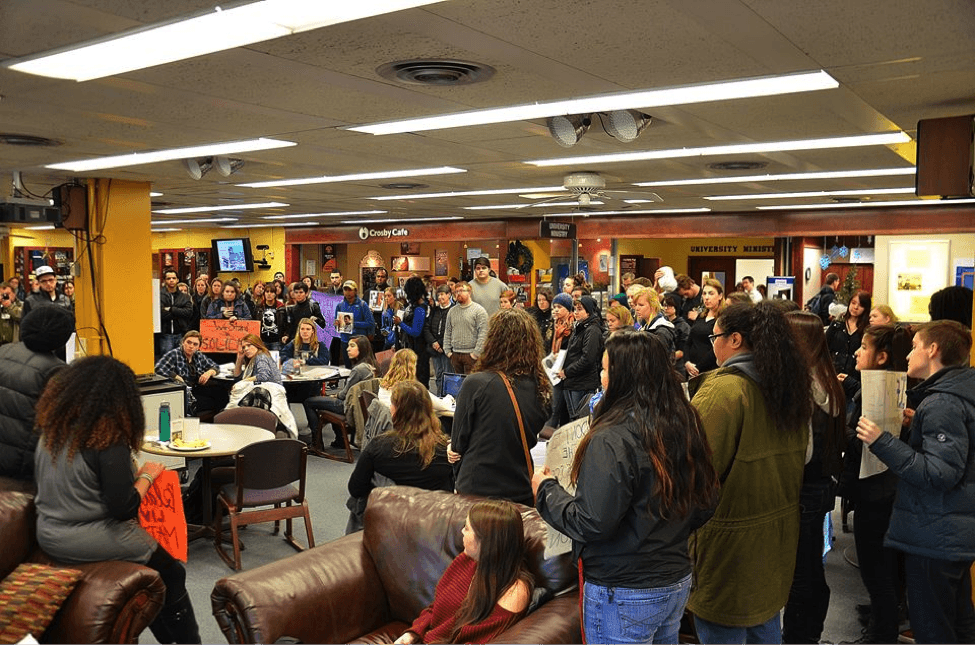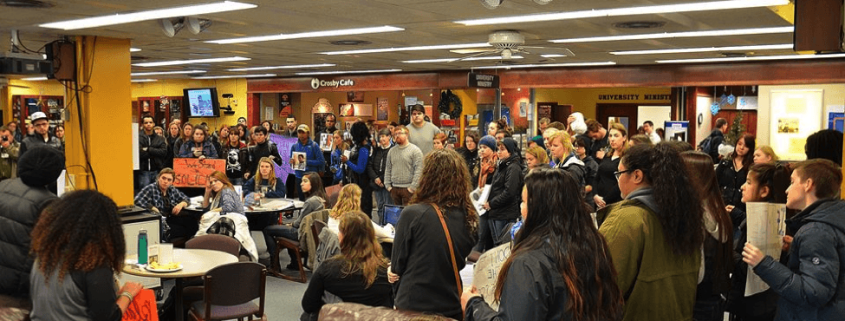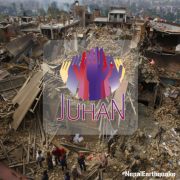Men and Women For, and With, Others: Let Us Reflect
BY PAUL QUIÑONEZ | February 6, 2015
As last year came to an end, I couldn’t help but ponder a phrase that is often said at Jesuit institutions across the nation: “Now let’s reflect.” In August I returned to Gonzaga for my third semester as a Zag. After spending a semester in Washington, D.C., I was deeply excited to be back. I decided to participate in a pre-orientation program for students of color and first-generation college students. While speaking to the students about why they chose Gonzaga, many mentioned its friendly atmosphere and strong school spirit. Though I do not regret having made the decision to attend Gonzaga, and am still deeply proud of my university, this year I have begun to see more clearly its flaws that hide behind its sometimes superficially “friendly,” “respectful,” and “welcoming” community.
In September, Hispanic Heritage Month was being celebrated across the nation, and Gonzaga partook in the festivities with a special dinner. As a Mexican immigrant, I am appreciative of people who want to learn more about my culture and celebrate it. However, when I arrived at the dining center, I was surprised by what I saw. The cafeteria was decorated with cacti and everyone on staff was wearing obnoxious sombreros and ponchos. It seemed to me that an opportunity to learn more about the Hispanic-American community, support “global engagement,” and promote “intercultural competence” was wasted. Instead, the organizers of the dinner chose to embrace and promote stereotypes without thinking of its potential effects on Gonzaga’s students.

Gonzaga University students host a die-in
At the time I thought that I might have been too “sensitive” and that the dinner was put on by Sodexo, not Gonzaga. So, I decided to let it go. Then, Halloween came along and I was looking forward to participating in “Gonzaga Scares Hunger.” During Gonzaga Scares Hunger hundreds of students spend part of their evening trick-or-treating for canned food. This, I thought to myself, is the social justice minded community that I am proud to be a part of. Yet, the day was tarnished by members of the community who decided that it would be appropriate to use other cultures as costumes and jokes. Even more disappointing was the fact that a university-operated Facebook page uploaded an image of sophomores dressed as tacos and “Mexicans” with the following caption: “We love the energy on Halloween here. . . . It’s really high energy and the people aren’t afraid to be weirdos. It’s socially acceptable to be weird.”
As the semester came to end, the nation became engaged in a debate over police brutality. To raise awareness about the situation, more than 100 Zags filled up two floors of the Crosby Student Center and partook in a “die-in.” Following the demonstration, President Thayne McCulloh made a public statement regarding the developments:
Yesterday, dozens of Gonzaga students took the opportunity to demonstrate active solidarity with those who have been protesting elsewhere by staging a “Die-In” on the floor of Crosby Center at Noon. The Die-In format was to lie on the ground as if dead for 4.5 minutes, which symbolizes the 4.5 hours that Michael Brown’s body was left on the ground without attention after being shot numerous times by a police officer. We recognize that his death, as well as Mr. Garner, Akai Gurley and a long list of other African American males, are part of a larger legacy of structural racism in our society.
While I was proud of everyone who participated in the event, and of our president for finally taking a stance, I could not help but wonder what took so long. Why was our university so willing to bombard its student body with emails asking it to help send an accounting team to a national competition, but avoided more controversial issues? Why did it do so when it claims to be committed to social justice issues, and dozens of other Jesuit institutions across the nation were speaking up?
President McCulloh additionally stated that, “in the New Year I will appoint a University Commission on Diversity. . . . In my view, awareness of racial injustice also compels us to be mindful in our everyday discussions and actions—in our classrooms, residence halls, sporting events and meals. . . .” It is my hope that while creating this new commission, Gonzaga’s administration reflects on its mission and begins living it out. It is time to truly be “[an] exemplary learning community that educates students for lives of leadership and service for the common good. [And to keep] with its Catholic, Jesuit, and humanistic heritage and identity [by] . . . [developing] the whole person”. It is time for Gonzaga, and other Jesuit universities across the nation that are struggling to live up to their missions, to fulfill their promise of creating men and women for, and with, others.
Paul Quiñonez is a political science and economics double major at Gonzaga University. Originally from Minatitlan, Colima, Mexico Paul was raised in Pasco, Washington and has always been interested in advocating for and serving the immigrant community. Throughout his high school years Paul did so by volunteering as an interpreter at the Franklin County Courthouse during elections, using his bilingual skills in assisting AARP as an interpreter during tax season, and by being a teacher’s assistant in an ESL classroom at Stevens Middle School.
Upon entering college Paul continued his efforts by meeting with elected officials in Olympia, Washington to advocate for the REAL Hope Act, a recently passed bill which granted undocumented students in Washington State eligibility for state financial aid. Additionally, Paul spent a semester in DC as a Congressional Hispanic Caucus Institute intern in Senator Stabenow’s office to acquire a better knowledge of the legislative process and how he can best serve his community. While in DC, Paul continued his advocacy efforts and participated in a march from Georgetown University to the White House in support of immigration reform, amongst other things.
Following his experience in Washington, DC Paul was accepted to the DHS Summer Scholars Academy in El Paso, TX. Through this experience Paul was able to observe a community which is directly impacted by immigration (El Paso is a border city) and its surrounding issues. Thanks to being in a border city during the time of the unaccompanied minors border crisis, Paul was also able to visit immigration detention facilities and see for himself how the federal government was attempting to cope with the issue. Now that he is back at Gonzaga University, Paul hopes to continue his advocacy work and share the social justice movements taking place at GU as part of the Ignatian Solidarity Network Media Team.











Leave a Reply
Want to join the discussion?Feel free to contribute!